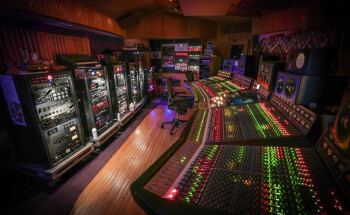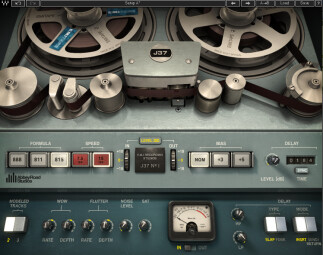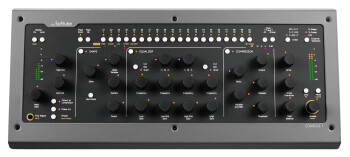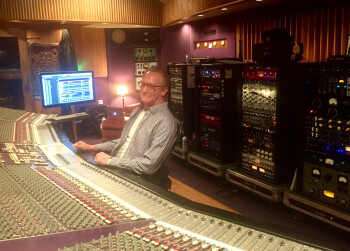An eight-time Grammy-award winner, engineer Michael Brauer has put his magic mixing touch on albums for Coldplay, John Mayer, and the Dave Matthews Band among many others. He is known for his unique compression technique, often referred to as “Brauerizing.”
Brauer’s method entails sending the tracks in the mix into separate sub-stereo busses, each with a different compressor. He augments that with five or more additional compressors on aux sends, to provide parallel compression.
Brauer spoke to us from his dual-room mix suite in New York’s legendary Electric Lady Studios, where he plies his trade amidst racks of vintage gear, an SSL console and a Pro Tools system featuring a large selection of plug-ins. We talked about his early days, when and why he chooses plug-ins over hardware, his monitoring setup, compression settings and more. He also gave us an in-depth explanation of his multi-compressor technique, which we present here in video form as a supplement to the interview.
Just a little bit of background: How did you get your education as an engineer? Did you have formal training?
No. I got it as an apprentice working at MediaSound Studios [in NYC]. I was hired in '76 as an intern and I became an assistant about a year later, '77, and then pretty much became a staff engineer by '78. Which back then was easy to do.
So you learned from watching the engineers you were assisting?
Oh yeah. They taught me. It was a great studio. The senior engineer was Fred Christie, a great, great engineer. And then below him were Joe Jorgensen and Michael DeLug, who was my mentor. Harvey Goldberg was also my mentor — he now does the sound for The Late Show with Stephen Colbert, which is why any band that plays there always sounds so great. And then you had Bob Clearmountain, and Tony Bongiovi, who’d brought his Motown experience to the studio. You couldn’t pick a better group to learn from. You just pick and choose. It was like going to a dream factory where you say, “Well, I’ll take what this guy’s doing and this guy’s doing and that guy’s doing.”
Did you spend a lot of time as a tracking engineer before you got into mixing?
You did everything back then. So I started off by simply doing overdubs. I was allowed to do a guitar overdub or a lead vocal or only strings or only percussion — whatever the overdubs were once the main session was done. Somebody else did the main session. I was there like seven days a week — and on the weekends I’d be recording something for the guys in our own band. You know, hitting record and running out there and playing the drums. Eventually, I got to mix a few things, just a song here or a song there, and then I might do the whole record and somebody else would mix it, and finally I got to do the whole record, including the mix. It was a very well thought out process where you were allowed to move on to the next step when they felt you were ready.
That’s not common anymore, right, since there are so few big studios?
There are no engineers mentoring the assistants, because studios only have assistants on staff. They don’t really have engineers on staff. The assistants eventually start engineering some sessions, like they do here at Electric Lady, and then they move on.
You’ve got all this incredible vintage outboard gear, but you also use lots of plug-ins. How do you determine which is appropriate for a given situation?

In the last five years it’s been a lot easier to choose a plug-in than to consider hardware. Because plug-ins have gotten to the point now where they really can emulate the tone and attitude that you get from a piece of hardware gear. It’s not just the GUI that looks exceptional [laughs], it’s the sound. So more and more now, it’s just easier to pick a plug-in than to use hardware. First of all, with hardware, if I have only one EQ, I can only put it across one instrument. While with a plug-in, it’s limitless. What I do now, is if I use a hardware EQ across something, I’ll probably print it, just for the sake of recall. Anything that’s hardware, except in my multibus [setup]. But if I’ve got something that’s really cool sounding, I’ll print it. Because today, there’s no such thing as recalling a desk. You can’t recall it. You may not get comments on the mix for a day or two, or a week. So, that’s why most people now mix in the box, because they can pull that song up, hit a button and boom, they make that change.
A recall is much more difficult if outboard gear is involved.
For anyone that’s on analog, you can’t recall a song a week later when you’re mixing another project. That’s what I did for years, and I’d have to put aside two or three days at the end of every record for recalls. And it was really inefficient. And now it’s at the point where the artist doesn’t even show up, so most of us, if not all of us who mix on a console, do stems. Once we’re done with a mix, we do like three hours of passes. Basically, every stereo channel has its own pass and then from that point on, any comments or any recalls are all done in the box, because you’re now basing it on the stems that you printed. And that’s the way it goes. The only people that don’t do that are the ones who say, “This is what I do, this is the mix, and I’m not doing a recall.”
Wow, I didn’t realize there were mixers didn’t do recalls.
Yes, but there are only a few people that still do. And their clients know that going in. But for the rest of us, that’s not the real world. At least not for the kind of music I’m doing. There’s always going to be comments, and there’s probably going to be several revisions. You make the changes, you send it. Going back to answering your question, the plug-ins have gotten so good now. In the past, when I would hear something that required an EQ or a compressor, I could scan through a bunch of compressors in my head, and hear the sound of each one — how it would sound with a particular instrument. I just imagined it in my head. Same with the EQ. Until the last five years or so, I couldn’t do that with a plug-in. If it was emulating something, it just didn’t sound the same. But then they started to sound really good. And then there were tools like de-essers, and now RX, which hardware can never touch.
RX is incredibly useful.
They [iZotope] really should win the Nobel Peace Prize. [Laughs] We use RX every day. Anyway, more and more I started hearing a sound and associating a particular plug-in with it. That’s when I knew that I’d made the switch. I knew at that point that plug-ins had really come a long way because I could get character and attitude from them, not just from hardware.
I understand you have quite a few Waves plug-ins. Which ones do you use a lot?
One of my favorites is J37
That’s the tape emulator?

Yes, and I have a whole lot of presets that go with it. I also use most of the Signature Series packages like Chris Lord-Alge’s. Generally, I’ll use his vocal plug-ins. I use a lot of Manny’s [Manny Marroquin]: his distortion and his EQ, primarily. I use the Tony Maserati plug-ins: his vocal chain and occasionally his acoustic guitar, because one of his presets sounds a lot like one that I’d set up, over the years. It’s very close. Sometimes if I have a couple of extra guitars I can just pop that in there, and I’ve got that sound immediately.
What else?
Occasionally, I’ll use Q-Clone, where you can just do an IR of an EQ or another processor and it gives you kind of a ballpark of it. I recently have been using it, and I’ve thrown it across to clone a couple of rare EQs that I have, and it’s kind of in the ballpark. If I really want the real thing, I’m going to use what I have, because there is no plug-in of my Datamix, the original Hendrix desk EQ. It gets the vibe of it, so that’s fun. I’ve been using the Waves One Knob lately. When I was mixing a record last week, I used that across the strings, I just started turning it up until it felt good. And then I used a lot of other plug-ins from somebody else, I’ll use the 610 from Universal Audio. The 610 sounded really good. And I used the J37, I used all three, and I just turned it into something that was a little bit older sounding, but really had great character. The strings came out sounding amazing.
Some of the things you’re talking about using have compression as part of their effects chain, like the Waves Signature Series plugs. Are you taking the compressor out of those since you have your own compression setup?
No, it’s just a sound. I’m just putting it across, I’m doing it obviously in the box to begin with. Sometimes I’ve already done some processing, and then what it does is tames it in a way that allows me to push the compressor better. Because sometimes, if the sound is too untamed and too transient, you’re kicking in the compressor sooner than you need to. So sometimes I’ll tame it down a little bit. But it’s also just a sound. I’m not thinking much about anything. I’m putting it across, and I go, “Oh, that sounds good.” That’s the rule.
I think people will be liberated to hear that a mixer of your caliber would use someone else’s effects chains and presets. There are a lot of engineers who might say, “I can’t use that, I’ve got to do it myself from scratch.” To know you would use a Manny Marroquin or Tony Maserati plug-in is pretty cool.
Understand that all three of these guys are really good friends of mine. Tony used to assist me, years ago. And Manny and I have become very, very close friends over the years, and same with Chris. So for me, there are times when I go, “Gosh, I feel a little guilty about this [laughs], because it’s so quick. And then I go, ”Ah, fuck it. So what." [Laughs] It’s just a tool. It’s down to the creativity that applies to the situation. So, I have no qualms about using any of their plug-ins. I also use the Eddie Kramer Master Tape plug-in. I have a bass setting with it. Eddie and I have become friends over the years, because of my working at Electric Lady. He’s a great, great guy — obviously a legend, but also a great guy. I also use Abbey Road Reel ADT, which was based on the Abbey Road doubler. It really depends on the music I’m doing. I’ve been using Vitamin a little bit, that’s kind of a multiband compressor.

Do you get a lot of large sessions with say, 100 tracks?
The average is 100.
Wow. How do you manage so many tracks without it becoming overwhelming?
For the most part I’ve trained my assistant on how to group a lot of this stuff. If there’s 25 tracks for strings, I don’t need 25, I need two.
What’s the average amount of time it takes you to mix a song? A few hours?
Yeah, generally a few hours.
So you don’t let the mix sit overnight or anything?
No, I take ear breaks when mixing. And then I end up mixing it on this radio behind me. It’s a little boombox. When I’m really happy, I know it, and I print it, and I send it off and then I have a hybrid room, which used to be the live room. So if I’m mixing two songs a day, I’ll have my assistant start stems once I’m done with a mix in the main room, and then I’ll come into the hybrid and start mixing another song.
How is that room different?
It’s a mini-me of the main room. What I have in there are still the basics of my multibus approach. My multibus sub-stereos are still based on my two main center racks. So I have my ABCD [see included video for explanation of Brauer’s compression setup], but they’re coming up on summing mixers. So I have my A, my B, my C, my D. I have my mastering rack, which has the basics, almost like I have in the main room. And then I have this really, really cool setup, the Softube Console 1, which basically feels very much like a console. It’s an emulation of a [SSL] 9000 or a 4000 desk. I’m really getting to love it. It’s not like it’s a compromise. I’m actually going in there, and the mixes that are coming out are really, really cool. If I have to mix two songs a day, which is usually the case, as soon as I’m done in here at 1:30, I just go in there, and I start mixing another one.
Besides the boombox, what are you using for monitors?
I have ProAc [Studio] 100s in both rooms. Which have always done well, but in today’s music it’s good to have bigger speakers. Because for the last ten years, with the kind of bottom end that is required, you really need to be able to hear it and mold it in a special way. And ProAcs, as great as they are, won’t let you hear that stuff down in the 40s and 60s.
Do you use a subwoofer?
Not on the ProAcs. But in main room I have my ProAcs, and I also have my ATC 50s on the outside and a big-ass sub, like a 15". And then on the other side of my console I have my ATC 25s and obviously the old Yammy’s [Yamaha NS-10s] sitting on top.
Do you still use the NS-10s?
Interestingly, I was mixing a record yesterday, and I asked the label guy what he was listening to it on, and he said “I’ve got Yamahas.” And I said, “How are you going to hear the bottom end?” But he said, “These are good.” And I said, “OK, ” so then I just started mixing, making all the changes, so I could hear the same thing he was hearing, so when he was commenting, I would know what he was talking about. The NS-10s still have their uses. They’re still sitting there. They’re happy.
Do you have typical starting settings that you use for compression, as far as ratios and attack/release for specific types of sources, or do you always dial it in from scratch?

Well, my ABCD, is what it is. I don’t mess with that. On the drums, I may vary the threshold a bit. If it’s hitting too hard I can lay it back. That’s about it, so those are always the same. And I generally have a starting point on my kick and snare, because it’s a couple of Motown EQs that I just love, because they’re very fat and natural.
Motown EQs?
Motown only had these as EQs. And they were used at Motown, at Hittsville. That’s all they had. And it even says Motown Recording Company or something like that on the little tag.
Those were the actual ones that were there?
Yes.
Wow. You were talking about compression starting points.
For piano, there are certain things that I start with, I’ll pop it in on the inserts. If it sounds good, then I’ll do it, if not I’ll put something else in. There’s always some kind of a starting point, at least to go “Okay, so how does this work for this record?”
You mentioned that on the drums you often set the compressor with a fast attack and release. I know, for example that on drums, a really fast attack is going to lessen the transients.
Well, if they do, you can also send the tracks through the unprocessed stereo [bus] (parallel compression) where you have full transients.
So there’s your parallel compression right there.
Right. So I can get this amazing depth on the drums, but it still has a lot of punch and attack. So how does that happen? Because I’m using the combination. And, the fast attack doesn’t mean that it’s not in the red. Sometimes it’s in the red, but at that point, if there’s that much compression going on, yes, it’s going to affect the attack. But there are other times where it’s just grabbing the transients a little bit. But any time that it feels like it’s starting to soften a little, I just send it to the stereo bus, and now I have my unprocessed with full transients and then they’re processed, together.
What about on vocals is there a typical compression setting you like to start with?
Vocals are completely different, because I make up the vocal by using five different compressors, and each one has a different sound to it. One is for the nasal area, one is for head tone, one is for chest, one has a lot of urgency to it, and one has a crush to it. I’ll just take those and I’ll blend them together and that’s my vocal sound. And those are five different mono compressors all going to the stereo bus. Blend those together and that’s my vocal sound.


